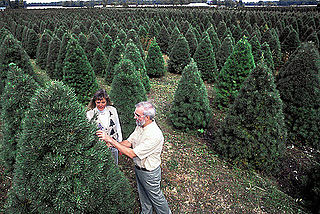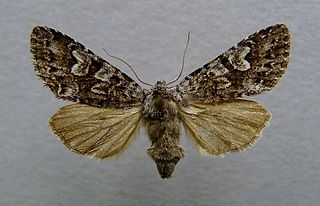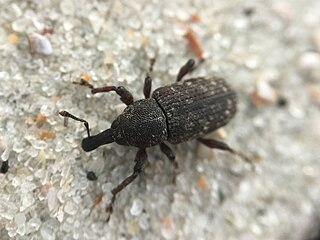
The Curculionidae are a family of weevils, commonly called snout beetles or true weevils. They are one of the largest animal families with 6,800 genera and 83,000 species described worldwide. They are the sister group to the family Brentidae.

The pine beauty is a moth of the family Noctuidae. It is a common species of pine woods in Europe. The distribution area extends from Portugal to western Siberia, the Caucasus and Asia Minor. In the north it extends to the Arctic Circle, in the south it is found in Ceuta in Northern Africa in and southern Italy.

The ring-necked dove, also known as the Cape turtle dove or half-collared dove, is a widespread and often abundant dove species in East and southern Africa. It is a mostly sedentary bird, found in a variety of open habitats. Within range, its penetrating and rhythmic, three-syllabled crooning is a familiar sound at any time of the year. Its name is derived from the semi-collar of black feathers on the lower nape, a feature shared with a number of Streptopelia species. Like all doves, they depend on surface water. They congregate in large flocks at waterholes in dry regions to drink and bathe.

Diaprepes abbreviatus, also known as the diaprepes root weevil, citrus root weevil and sugarcane rootstock borer weevil, is a species of weevil that is native to the Caribbean, where in Spanish it is colloquially called chichí. It has become an invasive pest in several locations in the United States.

Hylobius abietis or the large pine weevil is a beetle belonging to family Curculionidae. This species is widely regarded as the most important pest of most commercially important coniferous trees in European plantations. Seedlings planted or arising from natural regeneration after clear felling operations are especially at risk. The adult weevils cause damage by eating the bark of seedlings around the 'collar' of the stem, thus 'ring-barking' the tree seedling which usually results in its demise.

Pine and fir trees, grown purposely for use as Christmas trees, are vulnerable to a wide variety of pests, weeds and diseases. Many of the conifer species cultivated face infestations and death from such pests as the balsam woolly adelgid and other adelgids. Aphids are another common insect pest. Christmas trees are also vulnerable to fungal pathogens and their resultant illnesses such as root rot, and, in the U.S. state of California, sudden oak death. Douglas-fir trees in particular are vulnerable to infections from plant pathogens such as R. pseudotsugae.

Erodium moschatum is a species of flowering plant in the geranium family known by the common names musk stork's-bill and whitestem filaree. This is a weedy annual or biennial herb which is native to much of Eurasia and North Africa but can be found on most continents where it is an introduced species.
Hylobius warreni, Warren's rootcollar weevil, is a common pest of spruce and pine throughout Canada. It causes considerable damage to native species of spruce both in natural stands and in plantations.
Cylindrocopturus eatoni is a species of weevil commonly found in Oregon. The adults of the species are black and densely covered with grayish scales. The species is a good flier, but it often hops when disturbed, which is why it is often mistaken for a leafhopper. It lays its eggs singly in niches excavated in the bark of a main stem and its twigs. Cream-colored larvae hatch a few days later and begin tunneling in the outer layers of the roots, feeding on the phloem and xylem. The larvae pupate in spring. The species eats young ponderosa and Jeffrey pines. Its common name is pine reproduction weevil.
A root crown, also known as the root collar or root neck, is that part of a root system from which a stem arises. Since roots and stems have quite different vascular anatomies, major vascular changes take place at this point.

Papestra biren, the glaucous shears, is a moth of the family Noctuidae. The species was first described by Johann August Ephraim Goeze in 1781. It is found in most of Europe, but not in the southern parts of the Iberian Peninsula, Italy and Greece. Outside of Europe it is found in Kashmir and through the Palearctic to Siberia, Central Asia, Amur, Kamchatka, the Russian Far East and Japan. It was introduced in Newfoundland in 1935 and has since then extended its range ever more southward within North America partly overlapping with Papestra quadrata(Smith, 1891). It rises to 2200 m above sea level in the Alps.

Fusarium circinatum is a fungal plant pathogen that causes the serious disease pitch canker on pine trees and Douglas firs. The most common hosts of the pathogen include slash pine, loblolly pine, Monterey pine, Mexican weeping pine, and Douglas fir. Like other Fusarium species in the phylum Ascomycota, it is the asexual reproductive state of the fungus and has a teleomorph, Gibberella circinata.

Hylobius transversovittatus is a species of weevil in the family Curculionidae. It is native to the Old World where both adults and larvae feed on purple loosestrife. This plant is regarded as an invasive species in North America and the weevil has been introduced into both the United States and Canada in an effort to control the plant.

Liparus coronatus is a species of beetles belonging to the family Curculionidae.
Hylobius pales, the pales weevil, is a species of pine weevil in the beetle family Curculionidae. It is found in North America.

Hylobius aliradicis, the southern pine root weevil, is a species of pine weevil in the beetle family Curculionidae. It is found in North America.
Hylobius radicis, the pine root collar weevil, is a species of pine weevil in the beetle family Curculionidae. It is found in North America.
Hylobius congener, the seedling debarking weevil, is a species of pine weevil in the beetle family Curculionidae. It is found in North America.
Hylobius pinicola, the couper collar weevil, is a species of pine weevil in the family of beetles known as Curculionidae. It is found in North America.

Diplodoma laichartingella is a moth belonging to the genus Diplodoma. The species was first described by Johann August Ephraim Goeze in 1783.














